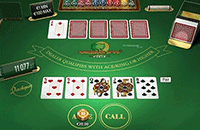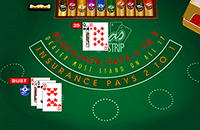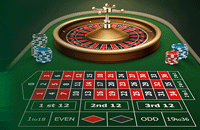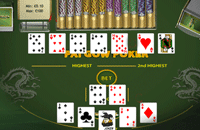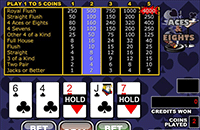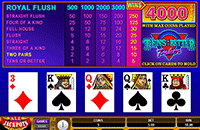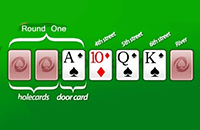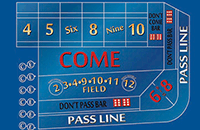Omaha Hi-Lo Poker-Rules Strategy & Tips
How to Play Omaha Hi-Lo Poker
Omaha Hi-Lo is a poker game that uses community cards – These are cards that all players at the table can use in conjunction with their own hole cards, which in the case of Omaha Hi-Lo Poker is 4. The aim of the game, as with any poker game, is to make the best possible 5 card poker hand. However, where Omaha Hi-Lo differs from most is that you sometimes need to make 2 poker hands, a Hi hand and a Lo’s hand. More of this later.
Omaha Hi-Lo Poker is not as popular as some version of online poker such as Texas Hold’em and Omaha. The rules are the same as in Omaha for the Hi hand. In Omaha Hi-Lo, as in Omaha, all players receive 4 ‘hole’ cards at the start of a hand. An important thing to remember for Omaha Hi-Lo is that you must use 2 of your 4 hole cards for the Hi hand and 2 for the Lo hand where applicable. You cannot choose 3 of your hold cards and 2 of the community cards for example. You can choose 2 different cards for the Hi hand and the Lo’s hand if you wish, but for each, you can only select 2 hole cards and 3 community cards.
In a cash game, you can sit down with your own money and leave at any time with the chips that you have in front of you. If you choose to play either a multi-table tournament or a sit and go, you will all start with the same number of chips for the same buy-in and play continues until one player has all the chips in play. Money is paid to the best-placed players, the number of players who end up ‘in the money’ depends on entrants, but winnings are only paid once the tournament has finished so you cannot walk away at any time with funds like you can in cash games.
Omaha Hi-Lo Rules
Omaha Hi-Lo uses one deck of 52 cards. All cards count at their respective values with Aces counting as either high or low for both hands which can be very important in this game.
The rules in terms of betting rounds are essentially the same as for Omaha except when it comes to determining the winning hands.
A player is designated as the dealer for each hand. This player has a ‘button’ in front of them to signify this. Although this player won’t physically deal the cards, the position of this button determines other actions like who will receive cards first and who will be first and last to act. The cards are dealt with each player starting with the player on the left of the dealer. This dealer button moves around the table after each hand in a clockwise direction.
Before each hand commences, the player to the dealer’s left places a bet known as a ‘small blind’. This is necessary for them to be dealt into the hand. This amount is the same each hand in a cash game, the amount depends on the table limits, whilst in a tournament, these bets increase at predetermined intervals which ensures the tournament will finish as players bet higher and higher amounts. The next player to the left of the small blind, effectively 2 places to the left of the dealer, pays another forced bet, this one known as the big blind. This is usually twice the amount of the small blind. The dealer button moves around the table after each hand to ensure all players take their turn at placing these bets ensuring fairness in the game and also that there is money in play for each hand.
When these 2 bets have been placed, all players receive 4 cards face down that only they can see. The player to the dealers left, the small blind, gets a card first with play continuing in a clockwise direction. The dealer is the last to receive cards.
It is now time for the 1st of 4 betting rounds. As the 2 players to the left of the dealer have already placed a bet, the player to the left of the big blind is the first to act now. This gives an advantage to those in the blinds as they will be the last to act and will, therefore, have a better idea of what other players have.
There are several options each player has at this point. They can ‘Call’ the current largest bet (place a bet equal to the largest one so far, this will be the big blind unless someone else has previously ‘Raised’), Raise (place a bet of more than the previous highest bet, different table limits have different rules about how much this can be, it normally needs to be at least double the big blind amount) or Fold (if you don’t feel it is worth Calling the highest bet as your cards aren’t that good, you throw your cards away and are out of the hand without the need to pay any further funds).
Play – otherwise known as action – now continues to the next player on the left of the previous one until all players have either Called the highest bet or Folded and left the hand. If the action gets back to the big blind, who is the last player to act in this betting round, and no one has Raised, the big blind can ‘Check’ which effectively means he Calls the highest bet without needing to put more chips in as he has already matched the highest bet with his big blind bet.
When all players have either Called or Folded, 3 cards are dealt face up in the middle of the table. This is known as the ‘Flop’ and the first of 5 Community cards that all players can use.
We now have a 2nd betting round for all remaining players. This is the same as the last betting round except that action starts with the 1st player to the Dealers left who is still in the hand, the player who placed the Big Blind. The first player can ‘Check’ if they wish as no forced bet is in play in further betting rounds, this means they effectively Call the highest bet which is currently nothing. No chips need to be added at this point, although if any other player Raises, all players need to place chips of this value to continue in the hand.
As before, the betting round ends once all players have either Called or Folded. If there are at least 2 players still remaining, we go to the Turn, which is a 4th community card dealt face up for all players to use. A 3rd betting round now takes place the same as before with one difference, which is the minimum bet from now on is twice the value of the big blind, therefore if a player decides to Raise, the minimum they can bet is twice the big blind for that hand.
When this hand has been completed, a 5th and final community card is dealt, the River. This completes the cards available to use so at this point you will know your best hand for the Hi hand and whether it is possible that a player can have a qualifying Lo hand. More of that in a moment. There is then one final betting round the same as the last one.
If 2 or more players are still involved after this betting round, we go to Showdown to determine the winner/s. If all except one player has folded, that remaining player wins the pot.
The winning Hi hand is determined by the best 5 card poker hand using 3 of the 5 community cards and 2 of the 4 hole cards available to the player. Please remember that it needs to be this combination and you cannot use 0, 1, 3 or 4 hole cards, it needs to be 2 of your 4 hole cards and 3 of the 5 community cards.
Here is where Omaha Hi-Lo differs from Omaha, the Lo hand.
A qualifying Lo hand is one that contains 5 separate numbers from 1 (Ace) up to 8. Pairs of numbers don’t count, there need to be 5 unique values.
If 3 of the 5 community cards have separate values of between Ace up to 8, then it is possible for a Lo hand to be made. In this case, half of the pot goes to the best Lo hand and a half to the best Hi hand.
The best Lo hand is determined by the lowest values in the hand.
If 2 or more players have a qualifying hand, the lowest number is compared. If 2 or more players have a hand with the same lowest card, the 2nd lowest is compared. This continues until one player has a lower value card than the other, this hand is declared the winner of the Lo hand, if more than one player has the same value Lo hand in terms of all 5 cards, that part of the pot is split equally.
When deciding your best Lo hand, you can use the same 2 hole cards as for your best Hi hand or different cards for both. The same rule applies though that you need to use 2 of your 4 hole cards and 3 community cards for each.
Take a look at the example below.
This is the Showdown and there are 3 players left, Adam, Harry, and Alex.
As there are 4 cards valued at 8 or below in the community cards – Ace of Spades, 3 of Clubs, 5 of Clubs and 8 of Clubs, a Lo hand is possible.
Players need to use 2 of their 4 hole cards to make a hand, therefore only Adam with his 2 Diamonds and 6 of Diamonds has a qualifying Lo hand of Ace, 2, 3, 5 and 6. He wins half the pot for the best Lo hand.
However, he only has a pair of Kings for the best Hi hand and is beaten to that by Harry who has a flush, using the Jack and 10 of Clubs from his hole cards along with the 3, 5 and 8 of Clubs from the community cards. He, therefore, wins half the pot as the best Hi hand.
Omaha Hi-Lo can take some getting used to, so we suggest you try it for free at one of our recommended sites before you start playing for real money.
Omaha Hi-Lo Poker Strategy
Omaha Hi-Lo is totally different from most forms of poker and a lot harder to master.
That being said, because of this even if you only get a good grip on the best way to play, there is still money to be made against less experienced players.
The key thing to remember is that there are 2 hands that you are looking to make, so you need to consider the Lo hand at least, if not more than, the Hi hand.
An Ace is a great card to have in any form of poker, this is especially the case in Omaha Hi-Lo as it is the best Hi card and the best Lo card.
In fact, many players would not consider putting money into the pot pre-flop without an Ace in their hand.
It is only after the Flop though that you get a real feel for how the hand is likely to go and if there is likely to be a Lo hand or not.
30% of the time, there is no possibility of a Lo hand and therefore the best Hi hand will take the pot.
The top 10 starting hands in Omaha Hi-Lo are open to discussion, you won’t go far wrong raising though with any of the following:
AA23 DS
AA24 DS
AA23 Suited
AA25 DS
AA24 Suited
AA34 DS
AA23 Non suited
AA22 DS
AA35 DS
AA26 DS
DS = Double suited, so 2 cards of 1 suit and 2 cards of another
Suited = 2 cards the same suit, 2 cards of different suits
Non-Suited = 4 cards of different suits or the non-aces suited
Other playable starting hands (ones to play when in late position if no raise has been made)
AA2x
AA3x
AA45
A23x
A2KK
A2QQ
A2JJ
A345
AAxx
A2KQ
A2KJ
A2xx (with suited Ace)
A3KK
A34x
2345 (fold if no Ace appears on the Flop)
JQKA
TJQK
KKQJ
QJT9
234x (fold if no Ace appears on the Flop)
Any 4 cards between T and Ace
*x represents any card
Omaha Hi-Lo Tips
A2 is the new AA – In most games, a pair of Aces is the hand you are looking for to start. However, due to the nature of the Lo hand in Omaha Hi-Lo Poker, A2 is the one to look for. You would almost always want to see the Flop with these cards as you are guaranteed at least a share of the Lo pot if 3 of 3,4,5,6,7, or 8 appear on the board
Look for connectors – the closer together your cards are the better as Omaha Hi-Lo is very much a drawing game. If these are double suited, so much the better
Don’t bluff – in some forms of poker, bluffing is a key part, this is not the case with Omaha Hi-Lo though. As there are 2 hands to consider most of the time, it is going to be harder to bet a player off the pot if they have, for example, A2 and there are 2/3 Lo cards on the board, you are much more likely to get your fingers burnt if you bluff against them
Don’t stay in without a premium Hi or Lo hand – if you have a good Hi hand and a good Lo hand, the chances are neither will be good enough to win, especially if there are several players left in the pot. Stay in only when you have at least one hand which is the nuts or close
Be selective with your starting hands – The higher number of options all players have to mean the winning hand is likely to have to be much better than in Texas Hold’em, therefore avoid calling with low cards that aren’t double suited or consecutive
Get to know the players – Whilst this is important in all forms of poker, this is especially the case in Omaha Hi-Lo, if you can spot those players that call or raise with anything, you could well have a good advantage against them when you hit something good
Respect most big raises and bets – Again, true for all forms of poker but unless you have an exceptional hand or a lot of draws, get out if a big bet comes along
Do not overestimate your hand – The nut flush for example in Texas Hold’em would normally be an excellent hand and give you a great chance of winning, this is not the case in Omaha Hi-Lo especially if the board has paired as winning hands are normally a lot better
Work out your outs – A hand with 8 outs in Texas Hold’em would normally be worth playing, however, due to the increased number of starting combinations in Omaha Hi-Lo, it is possible to flop a hand with 13, 17 and 20 way Straight draws meaning it a lot less likely your hand will hold up
Do not always play unsuited Aces – AA preflop would be great in Texas Hold’em, in Omaha Hi-Lo though if you don’t have another card of the same suit, you need to really hit one of the other 2 Aces on the Flop otherwise there is little else to improve your hand
Be cautious in multi-way pots – If more than one other player is in the hand with you, the likelihood is that you will need the ‘nuts’ – the best possible hand – to ensure you win, don’t invest too much if you don’t have a chance of getting it
Related Articles:
Omaha Hi-Lo Poker Video Tutorial
Poker Hand Rankings
5 Card Draw Poker

